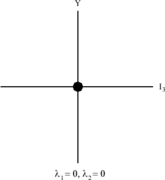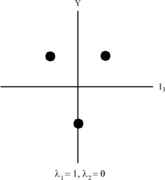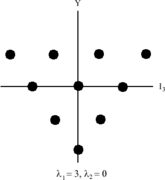Hypercharge
This article has multiple issues.Please helpimprove itor discuss these issues on thetalk page.(Learn how and when to remove these messages)
|
| Flavourin particle physics |
|---|
| Flavourquantum numbers |
|
| Related quantum numbers |
|
| Combinations |
|
| Flavour mixing |
Inparticle physics,thehypercharge(a portmanteau ofhyperonicandcharge)Yof aparticleis aquantum numberconserved under thestrong interaction.The concept of hypercharge provides a singlecharge operatorthat accounts for properties ofisospin,electric charge,andflavour.The hypercharge is useful to classifyhadrons;the similarly namedweak hyperchargehas an analogous role in theelectroweak interaction.
Definition
[edit]Hypercharge is one of twoquantum numbersof theSU(3) model of hadrons,alongsideisospinI3.The isospin alone was sufficient for twoquarkflavours — namely
u
and
d
— whereas presently 6flavoursof quarks are known.
SU(3)weight diagrams(see below) are 2 dimensional, with the coordinates referring to two quantum numbers:I3(also known asIz), which is thezcomponent of isospin, andY,which is the hypercharge (defined bystrangenessS,charmC,bottomnessB′,topnessT′,andbaryon numberB). Mathematically, hypercharge is[1]
Strong interactions conserve hypercharge (andweak hypercharge), butweak interactionsdonot.
Relation with electric charge and isospin
[edit]TheGell-Mann–Nishijima formularelates isospin andelectric charge
whereI3is the third component of isospin andQis the particle's charge.
Isospin creates multiplets of particles whose average charge is related to the hypercharge by:
since the hypercharge is the same for all members of a multiplet, and the average of theI3values is 0.
These definitions in their original form hold only for the three lightest quarks.
SU(3) model in relation to hypercharge
[edit]The SU(2) model hasmultipletscharacterized by a quantum numberJ,which is the totalangular momentum.Each multiplet consists of2J+ 1substateswith equally-spaced values ofJz,forming asymmetricarrangement seen inatomic spectraand isospin. This formalizes the observation that certain strong baryon decays were not observed, leading to the prediction of the mass, strangeness and charge of the
Ω−
baryon.
The SU(3) hassupermultipletscontaining SU(2) multiplets. SU(3) now needs two numbers to specify all its sub-states which are denoted byλ1andλ2.
(λ1+ 1)specifies the number of points in the topmost side of thehexagonwhile(λ2+ 1)specifies the number of points on the bottom side.
-
SU(3) singlet weight diagram,whereYis hypercharge andI3is the third component of isospin.
-
SU(3) triplet weight diagram
-
SU(3) septet, octet, and nonet weight diagramNote similarity with both charts on the right. The number used to describe the weight diagram depends on whether the particle(s) occupying the center of the diagram have one, two, or three distinct names.
-
Theoctetof lightspin-1/2baryons described in SU(3). n:neutron,p:proton,Λ:Lambda baryon,Σ:Sigma baryon,Ξ:Xi baryon.
-
SU(3) decuplet weight diagramNote similarity with chart on the right.
-
A combination of three up, down or strangequarkswith a total spin of3/2form the so-calledbaryon decuplet.The lower six are hyperons.S:strangeness,Q:electric charge.
Examples
[edit]- Thenucleongroup (protonswithQ= +1andneutronswithQ= 0) have an average charge of++1/2,so they both have hyperchargeY= 1(since baryon numberB= +1,andS=C=B′=T′= 0). From the Gell-Mann–Nishijima formula we know that proton has isospinI3=++1/2,while neutron hasI3=−+1/2.
- This also works forquarks:For theupquark, with a charge of++2/3,and anI3of++1/2,we deduce a hypercharge of1/3,due to its baryon number (since three quarks make a baryon, each quark has a baryon number of++1/3).
- For astrangequark, with electric charge−+1/3,a baryon number of++1/3,andstrangeness−1, we get a hyperchargeY=−+2/3,so we deduce thatI3= 0.That means that astrangequark makes an isospin singlet of its own (the same happens withcharm,bottomandtopquarks), whileupanddownconstitute an isospin doublet.
- All other quarks have hyperchargeY= 0.
Practical obsolescence
[edit]Hypercharge was a concept developed in the 1960s, to organize groups of particles in the"particle zoo"and to developad hocconservation laws based on their observed transformations. With the advent of thequark model,it is now obvious that strong hypercharge,Y,is the following combination of the numbers ofup(nu),down(nd),strange(ns),charm(nc),top(nt) andbottom(nb):
In modern descriptions ofhadroninteraction, it has become more obvious to drawFeynman diagramsthat trace through the individual constituent quarks (which are conserved) composing the interactingbaryonsandmesons,rather than bothering to count strong hypercharge quantum numbers.Weak hypercharge,however, remains an essential part of understanding theelectroweak interaction.
References
[edit]- ^Particle Data Group, ed. (2022),15. Quark Model(PDF)
- Semat, Henry; Albright, John R. (1984).Introduction to Atomic and Nuclear Physics.Chapman and Hall.ISBN978-0-412-15670-0.











